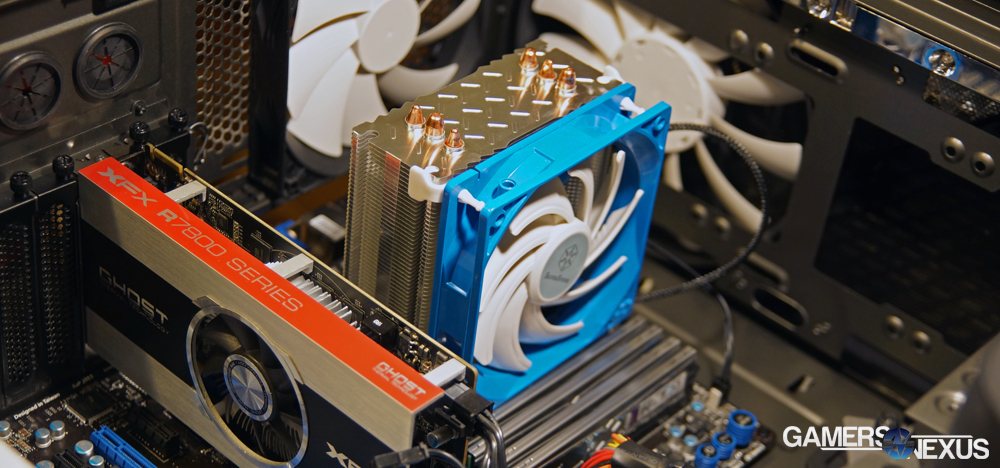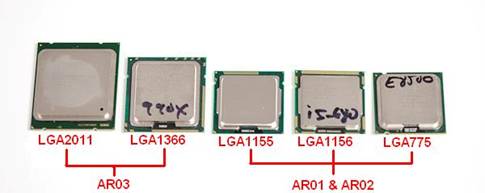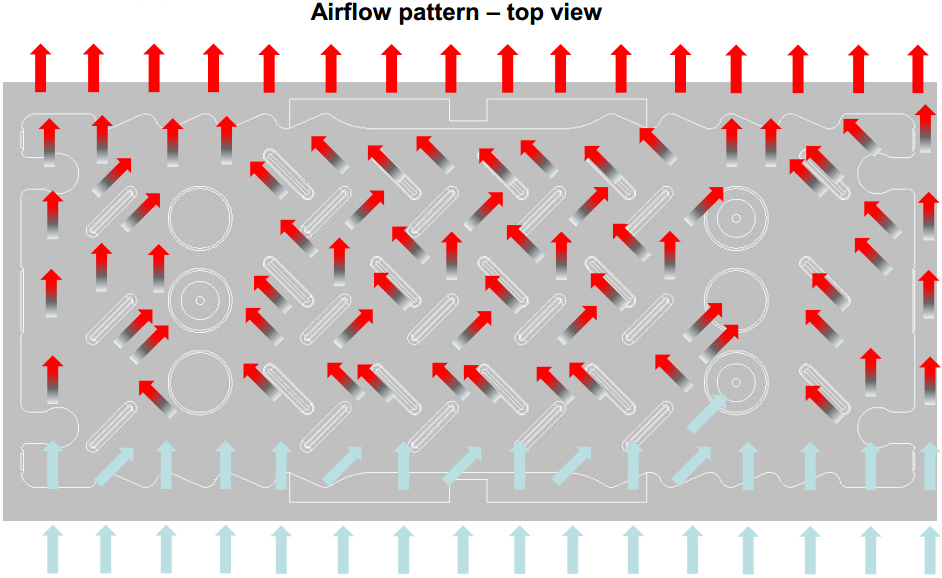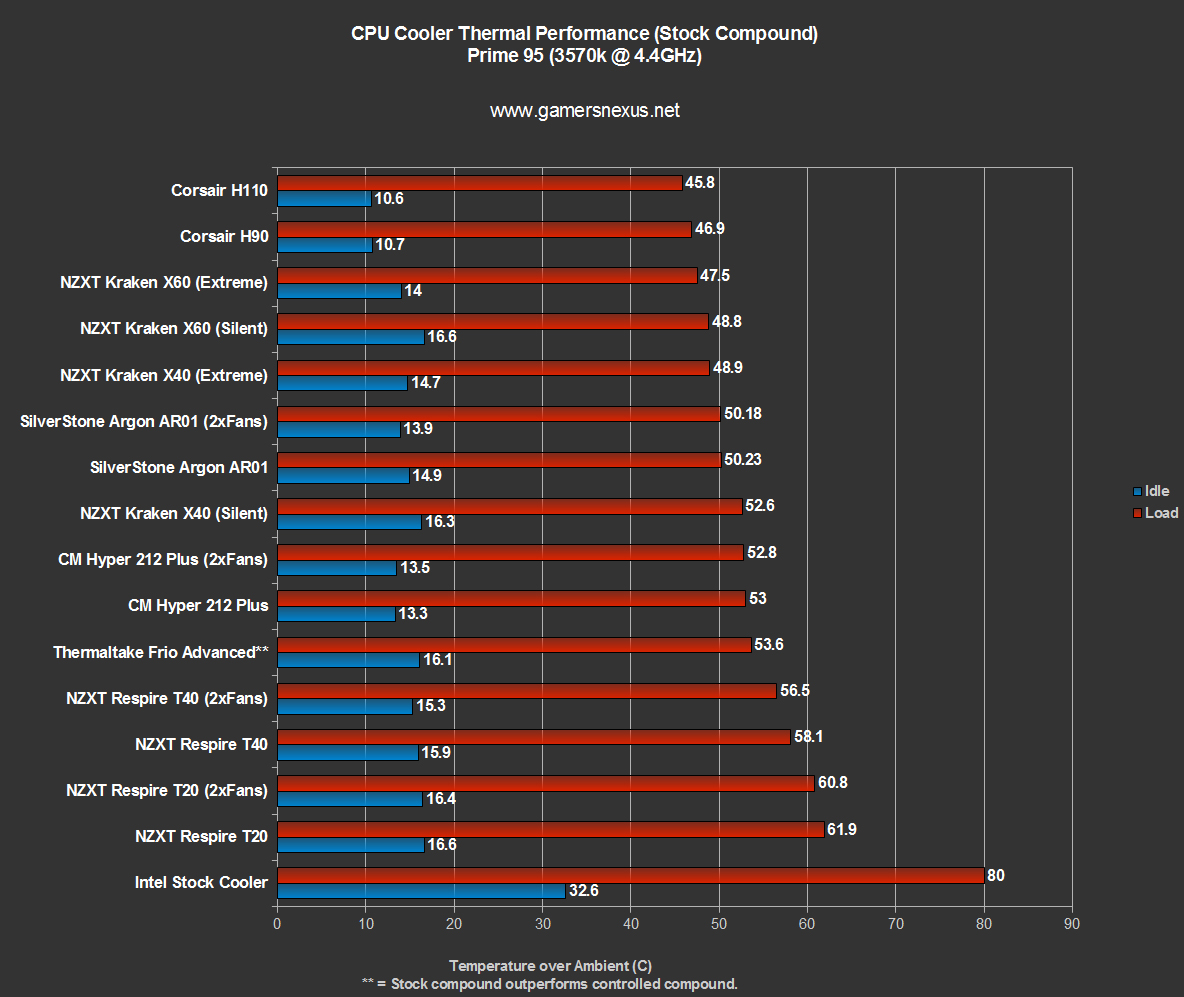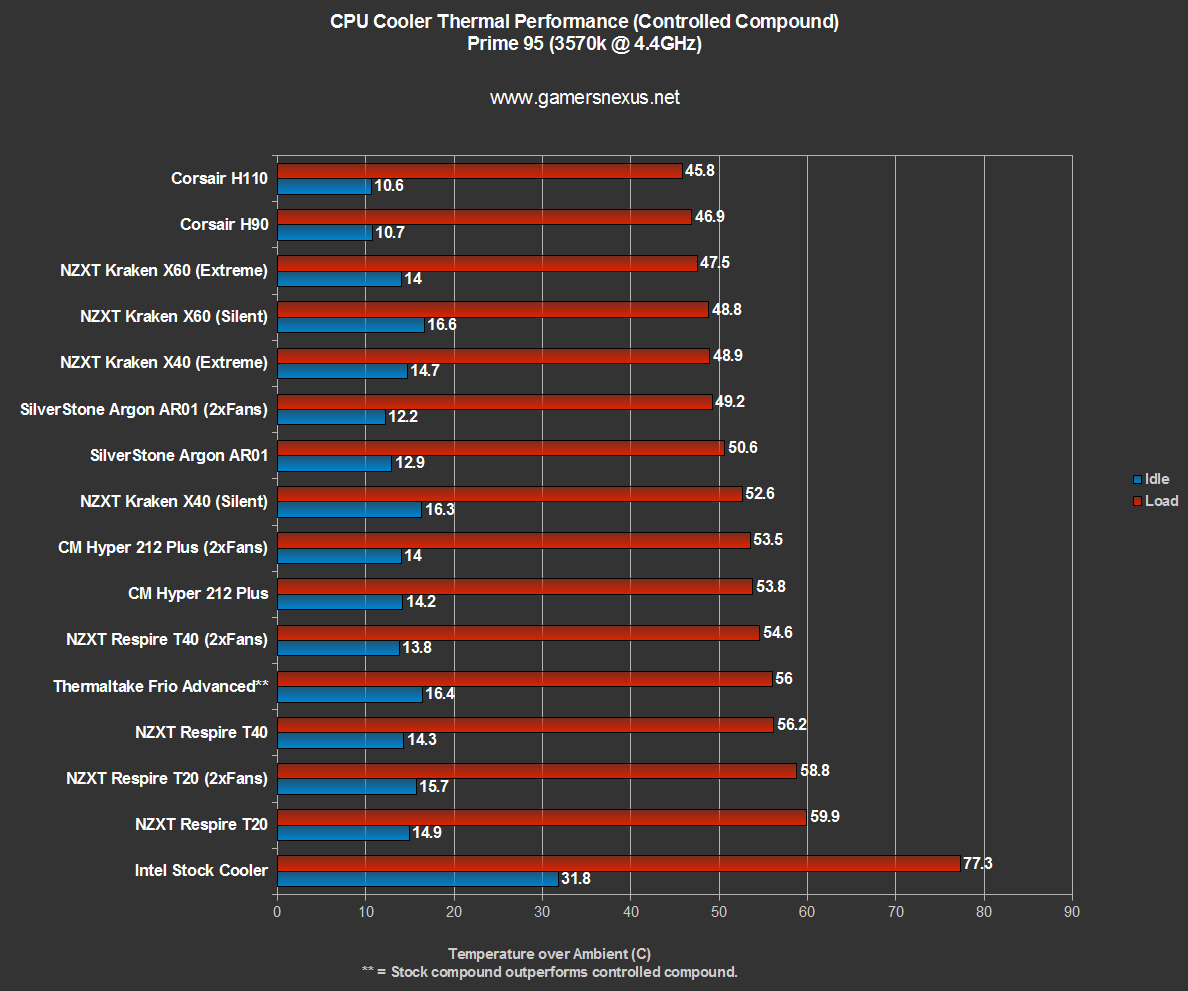Our history of working with SilverStone has been relatively limited, but we've always walked away impressed. This first happened with the SG08, then again with the Raven RV02 -- which now sits firmly at the top of our thermal bench for enclosures. In talking with the company, we've found that they feel incredibly confident in their products' performance and—while that's not uncommon in PR—they haven't been wrong yet. I can respect that.
The Argon AR01 cooler is another example of this: Having recently re-benched all our coolers on the 2013 GN Test Bench, SilverStone was eager to assert their dominance among air coolers. There are a few different models of the new Argon cooler, each purpose-built for different socket-types (and thus CPU sizes); the advantage to this is that—rather than ship a "one size fits all" unit, like the Hyper 212 or Respire T40—users can achieve peak thermal dissipation with optimized coldplate positioning.
Let's specifically look at Intel for demonstrative purposes: If you're not aware, the number accompanying LGA sockets is the pin-count for the socket. IB LGA1155 has 1155 pins that connect the socket and the CPU, SB-E LGA2011 has 2011 pins, and so on. As you can imagine, the physical substrate dimensions are dictated by the number of pins; this also tends to trend with more powerful (X-class) CPUs, which occupy their substrate with physically-larger silicon dies.
Of course, the die is covered by an Integrated Heat-Spreader (IHS) -- the copper plate with etched branding. Heat is transferred from the silicon to the IHS (with a thermal interface in between), then conducted into the heatpipes of a mounted CPU cooler (also filled-in by a thermal interface). After this point, normal capillary action and dissipation patterns apply - find a full walkthrough of how that works here.
This is relevant because the size of the IHS and physical CPU must be comparable to the size of the heatsink's coldplate. Mounting a massive, one-size-fits-all coldplate to an LGA1150 Haswell CPU might work, but it'll be inefficient. Mounting a smaller cooler (like the Respire T20, for a spectacularly inept example of "what not to do") to a larger SB-E CPU means you'll be incinerating your silicon due to uneven distribution of thermal dissipation between the IHS and coldplate. When I originally tested the Respire T20, it was done on our old LGA1366 bench - a larger CPU - and the coldplate barely covered the surface. Go too large, though, and your heatpipes will be spaced inadequately across the surface and lose much of their effectiveness.
This is why it's important to get a cooler of the correct size.
So, introductions to cooler engineering aside, let's get to this Argon AR01 review: In this SilverStone Argon AR01 CPU cooler benchmark & review, we'll look at performance vs. the Hyper 212 Plus, Respire T40 & T20, and even entry-level CLCs (X40, H90). Spoiler alert: As with the previous two SilverStone products we've reviewed, I walked away impressed. Not quite "floored," but not far from it.
SilverStone Argon AR01, AR02, & AR03 Specs - CPU Coolers
As mentioned above, SilverStone produces a few models of their Argon cooler - each for a different CPU socket type. The Argon AR01 and AR02 are recommended for LGA775, LGA1156, and LGA1155 socket types; the AR03 is favorable for larger sockets, like LGA1366 & LGA2011. We tested the AR01 on LGA1155 (3570k), as was recommended by the company's representative. You'll find the specs of each cooler below, for comparative purposes:
| Cooler Spec | AR01 | AR02 | AR03 |
| Heatpipes | 3x8mm | 3x6mm | 6x6mm |
| Dimensions | 120x50x159mm (WDH) | 92x50x134mm (WDH) | 140x50x159mm (WDH) |
| Fan Spec | 1000~2200RPM PWM fan Hypro fluid/oil bearing ~37.2~81.4CFM (55CFM AVG) ~40,000 hour life ~16.4~33.5dBA 120mm fan | 1200~2800RPM PWM fan Hypro fluid/oil bearing 56CFM ~40,000 hour life ~16~24dBA 92mm fan | 1000~2200RPM PWM fan Hypro fluid/oil bearing 37.2~81.4CFM ~40,000 hour life ~16.4~33.5dBA 120mm fan |
| Materials | Copper Heatpipes Aluminum Sink Direct Contact Coldplate | Copper Heatpipes | Copper Heatpipes |
| Compatibility | Intel LGA775/115X/1366/2011 AMD AM2/AM3/AM3+/FM1/FM2 | Intel LGA775/115X/1366/2011 | Intel LGA775/115X/1366/2011 |
| MSRP | ~$35 on Newegg | ~$28 on Newegg | ~$50 on Newegg |
SilverStone Argon AR01 Video Review & Hands-on / Installation
The cooler uses 3x8mm copper heatpipes on a Direct Contact coldplate (continuous surface), feeding up into a decent-sized aluminum sink. The fins are designed in a way that increases air turbulence, theoretically improving retention of intake air and channeling the heat in a more calculated, streamlined manner. Other than that, things are mostly standard in terms of overall materials composition and design basics.
SilverStone ditches the cheap, plastic fan rails found in most similarly-priced heatsinks (the ones we've hated on - given the frequent cracks), instead opting to use rubber pull-throughs. The rubber mounts use a barrel-like design to stick into the cooler, giving the added bonus of reduced vibration and noise prevention. A total of two fans can be mounted to the unit in push/pull configuration.
Staying on the fan front, the stock 120mm fan uses a few unique fan blade design tweaks to help with propulsion and turbulence mitigation; the stock fan's CFM output hovers around 55CFM @ 16-24dBA (closer to 24) but scales with RPM (PWM enabled, 1000~2200RPM, up to ~80CFM), with thanks given to its Hypro bearing. When we first wrote about case fan bearing differences, we covered fluid dynamic, but didn't talk about Adda's Hypro bearings. The "Hypro" name expands to mean "hydro-dynamic wave oil protection system." A deeper technical explanation of how Hypro bearings function can be found on Adda's website, here.
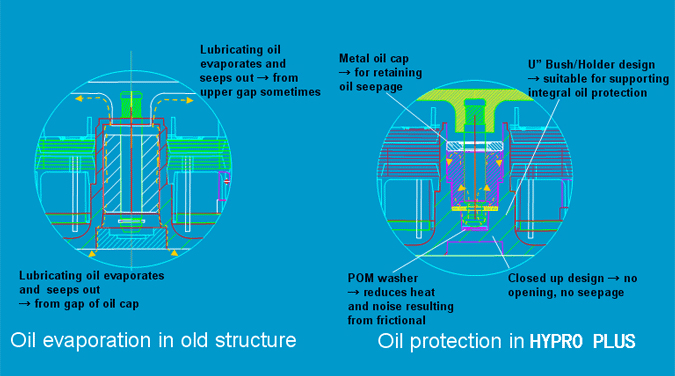
SilverStone Argon AR01: What's in the Box?
As expected, the cooler ships with standard Intel & AMD mounting brackets, a packet of 5W/mK thermal compound (good for a few uses, though you'll need a way to re-seal it), eight rubber mounting guides for up to two fans, the fan itself, and the cooler.
Installation is fairly standard. Drop the socket-appropriate backplate onto the board, screw it down with the correct screws (there are 2011 and 1155/1156 screws, so choose the right size), and then bolt the cooler down. Unlike the Respire units, SilverStone's Argon feels a lot more physically secure when mounted and seems to have overall superior build quality; the mounting process is easier than most low-end and mid-range coolers (with thanks given to actual, y'know, threaded screws and sockets), so there's really not anything to complain about.
That's all fine 'n dandy, but that's not what we care about. Let's jump to thermals.
CPU Cooler Testing Methodology
We have a brand new test bench that we assembled for the 2013-2014 period! Having moved away from our trusty i7-930 and GTX 580, the new bench includes the below components:
| GN Test Bench 2013 | Name | Courtesy Of | Cost |
| Video Card | XFX Ghost 7850 | GamersNexus | ~$160 |
| CPU | Intel i5-3570k CPU | GamersNexus | ~$220 |
| Memory | 16GB Kingston HyperX Genesis 10th Anniv. @ 2400MHz | Kingston Tech. | ~$117 |
| Motherboard | MSI Z77A-GD65 OC Board | GamersNexus | ~$160 |
| Power Supply | NZXT HALE90 V2 | NZXT | Pending |
| SSD | Kingston 240GB HyperX 3K SSD | Kingston Tech. | ~$205 |
| Optical Drive | ASUS Optical Drive | GamersNexus | ~$20 |
| Case | NZXT Phantom 820 | NZXT | ~$250 |
| CPU Cooler | (This is what we're testing) | SilverStone | ~$35 |
| Aftermarket Thermalpaste | Antec | ~$9 |
All of our testing is conducted in a temperature-controlled environment. Ambient is between 21C and 22C for CPU cooler tests. The graphs measure temperature in Delta over Ambient (C) - so the ambient temperature is subtracted from the component temperature.
Each test is initiated with a cold boot, where the system will sit idle for 15 minutes and collect thermal data. We use CPUID's HWMonitor Pro for thermal logging and tracking.
After this idle time, the system will launch a Prime95 instance running four torture threads on Large FFTs for maximum heat generation and power utilization. This is run for 15 minutes, throughout which the logging utility will collect the data we used in the below charts. A final round of idle time is allowed to ensure data consistency. Redundant tests are run in the event of unexpected results.
We keep a consistent case and airflow configuration for all CPU cooler tests.
Our degree-per-dollar chart is measured by using the stock cooler as a temperature baseline. We calculate Delta T between the tested coolers and the stock Intel cooler, then divide price by Delta T (example: $65 / dT 28C = $1.85/degree C). This is used for buyers who are looking for a perspective on relative value and aren't necessarily after each individual degree. For value charts where coolers utilize two fans, we assume an average price of $8 per additional 120mm fan.
All automatic fan controls are disabled for testing purposes. All system case fans and CPU cooler fans run at 100% load during testing. This means these tests will represent the cooling capacity when the CPU fan runs at its maximum speed and load consistently. If you would like to reproduce our results. you can disable fan control in BIOS - often under the "Hardware Monitor" tab.
SilverStone Argon AR01 Benchmark vs. Hyper 212, Respire T40, X40, etc.

Priced right near the Hyper 212 Plus and NZXT Respire T40, SilverStone's $35 Argon AR01 cooler should theoretically perform in the same general ~54C area. As always, we ran the tests with controlled and stock thermal compound and with single- and dual-fan arrays. This helps test the coolers on equal ground and has the added benefit of determining whether it's even necessary to purchase your own compound. The same goes for fans -- our testing often helps reveal whether an extra ~$7 fan investment is worthwhile, or if the stock config is powerful enough.
Notice: We do not apply controlled compound to CLCs.
Here are the tested configurations for the AR01:
- SilverStone Argon AR01 (stock fan, stock thermalpaste).
- SilverStone Argon AR01 (stock fan, controlled Antec Formula 6 thermalpaste).
- SilverStone Argon AR01 (2 fans, stock thermalpaste).
- SilverStone Argon AR01 (2 fans, controlled Antec Formula 6 thermalpaste).
Here are the results:
The above chart shows the stock thermal compound performance for all listed coolers. The results are mostly the same as the controlled section, so let's save analysis for that bit:
Somewhat surprisingly -- and maybe you noticed this as quickly as we did -- the AR01's idle temperature performance is second only to Corsair's H90 and H110 CLCs, outperforming every other cooler on the bench. Even more surprisingly, the AR01 outperforms NZXT's Kraken X40 when on silent settings, and performs nearly identically when on its preconfigured "extreme" setting; given that the noise levels are so close between the coolers, it's an easy choice for any budget builder. Back in our liquid cooler round-up, we noted that a high-end air cooler will often outperform mid-range CLCs when used in conjunction with a mid-clocked CPU, and this is a testament to that statement.
If you're doing serious OC/OVing, but not quite serious enough to warrant open loop cooling, then liquid coolers will start to widen the gap between air. This is the same reason we rarely see benefit to adding a secondary fan in our cooler tests: The airflow pathway is sufficiently saturated in our test configuration as-is when coupled with a quality cooler, and because the OC/OV is extremely stable (a good bin-out and experienced overclockers), this means additional fans rarely have significant impact.
For multi-fan configurations and opting for aftermarket thermal compound, neither appears worth it on the surface. If you grab the cooler, just leave it stock and be happy with it -- the "default" performance is solid, and an extra $7-$10 for added fans or alternative compound seems hardly worthwhile.
Looking to pure value, we jump to our dollars-per-degree chart:
The Argon's relative value rests comfortably toward the top, officially making it the best cooler we've tested in the $20-$40 range.
Conclusion & Final Thoughts
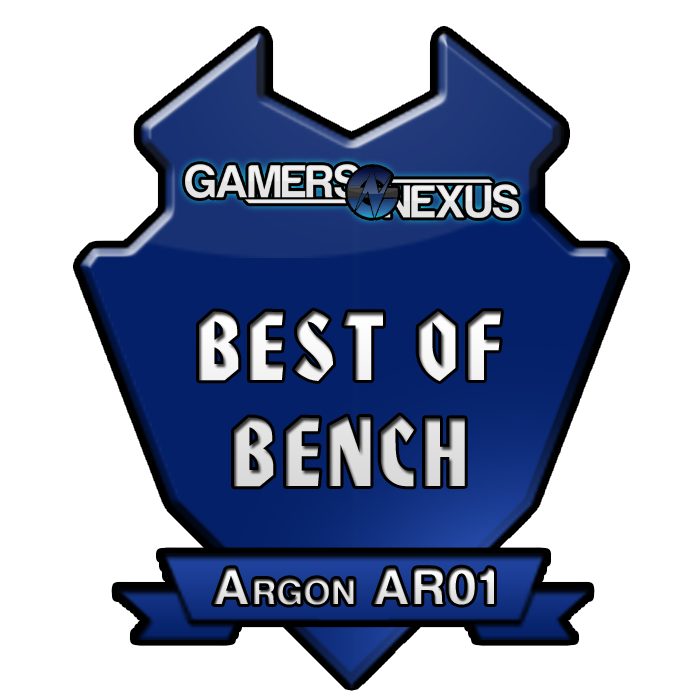 Simply put: Get it. The performance competes with mid-range liquid on a reasonable OC/OV, single-handedly defeats the famed Hyper 212, and dethrones the Respire T40 as our cooler of choice. If you're considering the T40 vs. Argon AR01 and they're roughly the same price, opt for SilverStone. If the T40 is on sale (it often hits $20 on TigerDirect) and you're on a budget, then get the T40.
Simply put: Get it. The performance competes with mid-range liquid on a reasonable OC/OV, single-handedly defeats the famed Hyper 212, and dethrones the Respire T40 as our cooler of choice. If you're considering the T40 vs. Argon AR01 and they're roughly the same price, opt for SilverStone. If the T40 is on sale (it often hits $20 on TigerDirect) and you're on a budget, then get the T40.
SilverStone once again looms over all its nearby competitors, firmly holding the "Best of the Bench" for CPU coolers (as of this writing), in good company with their RV02's positioning on our case bench.
- Steve "Lelldorianx" Burke.
